Key takeaways:
- Personalizing follow-up messages and referencing specific meeting points can significantly enhance communication and relationship building.
- Timing is critical; reaching out within 24-48 hours maintains momentum and makes the other party feel valued.
- Utilizing tools like project management software and email scheduling can streamline follow-up tasks and help keep conversations organized.
- Measuring the effectiveness of follow-ups through response rates and qualitative feedback can refine strategies and strengthen client relationships.

Understanding follow-up strategies
When I think about follow-up strategies, I often reflect on a meeting I had with a potential partner that didn’t go quite as planned. I left feeling uncertain, but I quickly realized that a thoughtful follow-up could change the trajectory of our relationship. Isn’t it fascinating how a simple email can either ignite interest or fizzle out potential collaboration?
One essential follow-up strategy I’ve embraced is personalizing my messages. Instead of sending a generic thank-you note, I take the time to reference specific points discussed in the meeting. For example, I once followed up by sharing a relevant article that aligned with a pain point my client mentioned—this not only highlighted my attentiveness but also positioned me as a valuable resource. How often do we underestimate the power of tailored communication?
Moreover, I’ve learned that timing is critical. Following up too soon can come across as pushy, while waiting too long may lead to being forgotten. I once followed up three days after a significant meeting, and it sparked a rewarding conversation that ultimately solidified our partnership. It’s all about finding that sweet spot, isn’t it? Adjusting your follow-up timing can make all the difference in creating a lasting impact.
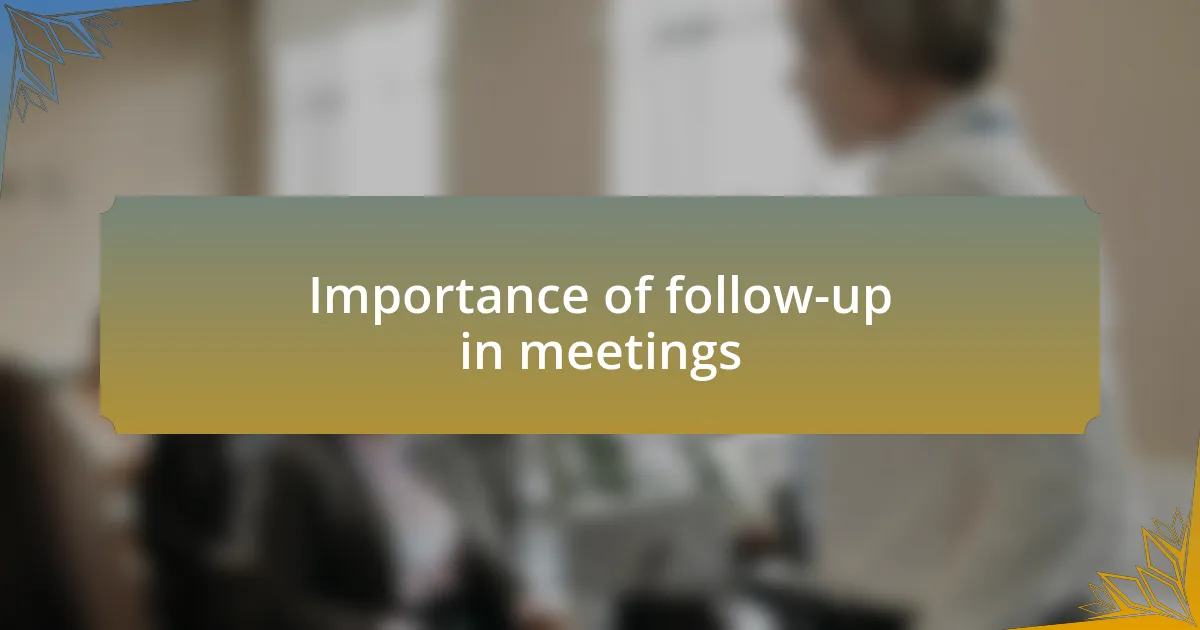
Importance of follow-up in meetings
The importance of follow-up in meetings cannot be overstated. I can recall a time when I neglected to check in after a crucial discussion. Months later, I discovered that a competitor had swooped in to secure the partnership I could have had. It was a stark reminder that diligent follow-up is often the linchpin of successful business relationships.
When I do follow up, I aim to reinforce the agenda we discussed, keeping it fresh in the other party’s mind. Recently, I reached out to a contact days after we brainstormed ideas together. In my message, I highlighted a particularly exciting suggestion we had, which revitalized our discussion and propelled us into a new project phase. How can we expect ideas to flourish if we don’t nurture them through timely communication?
Moreover, follow-up creates a crucial opportunity for feedback. After a meeting where I sought input on a new initiative, I followed up with a survey to gauge thoughts and feelings. Surprisingly, the responses allowed me to refine my approach in ways I hadn’t anticipated. Isn’t it fascinating how follow-up can transform a simple conversation into a dynamic dialogue?
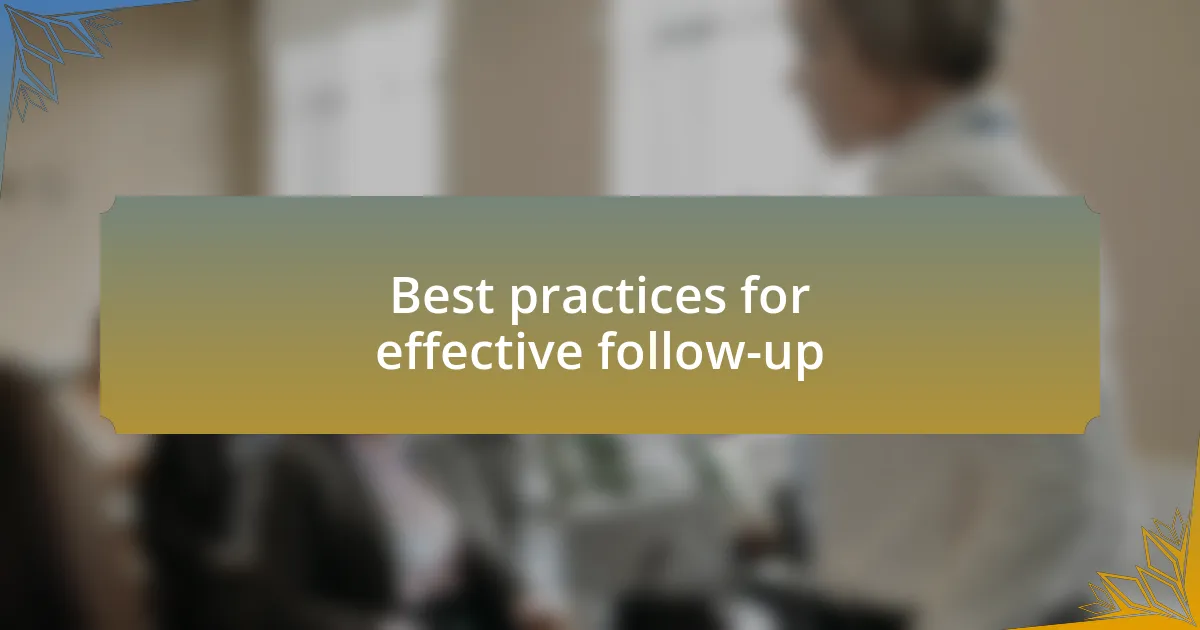
Best practices for effective follow-up
When I follow up after meetings, I make it a priority to personalize my message. For example, I once sent a thank-you note that referenced a specific joke shared during a brainstorming session, and it sparked a delightful conversation. This not only solidified our connection but also made my follow-up feel genuine, inviting further dialogue. Have you ever considered how a small personal touch can make a significant impact on your professional relationships?
I also believe in the power of brevity. After one meeting where we laid out ambitious goals, I sent a succinct recap of our action items rather than a lengthy report. This approach made it easy for my colleagues to grasp their tasks quickly and kept everyone focused. Isn’t it refreshing when communication feels straightforward, without unnecessary fluff?
Timing is another key aspect of effective follow-up. I always aim to reach out within 24 hours while the conversation is still fresh in our minds. After a recent networking event, I fired off a few emails that helped sustain the momentum of our discussions. Have you ever noticed how fast interest can fade after a meaningful encounter? Timely follow-up can make all the difference in cementing those initial connections.
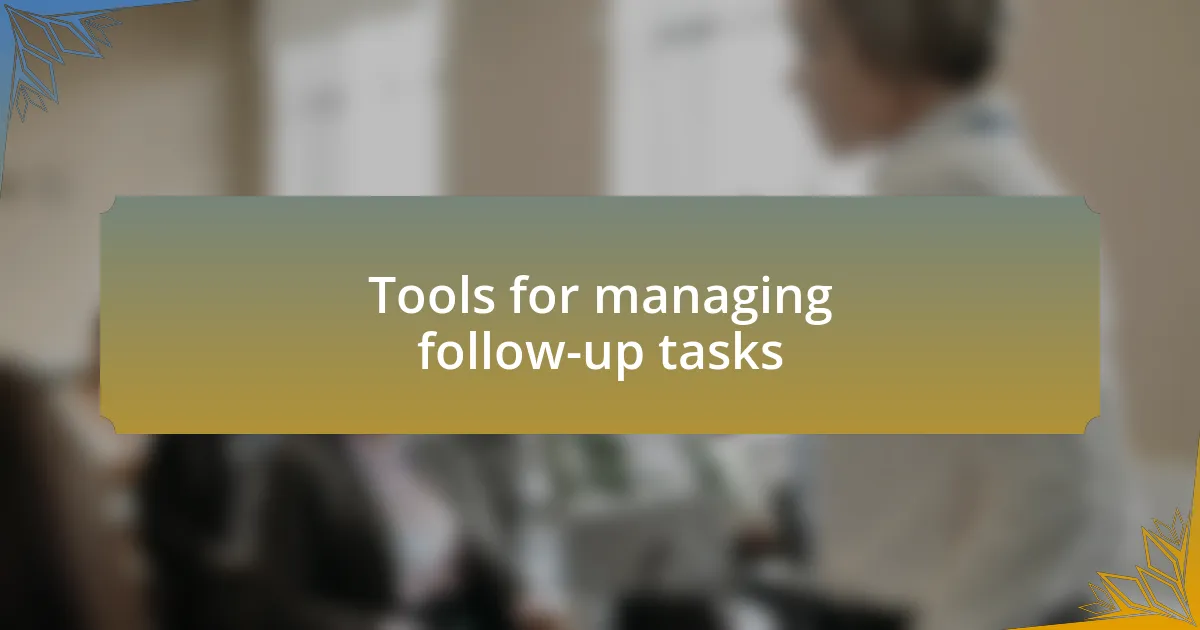
Tools for managing follow-up tasks
Managing follow-up tasks can be simplified with the right tools. I often use project management software like Trello or Asana, which helps me visualize action items from meetings. Just the other day, I created a board after a client meeting and labeled tasks based on deadlines. This not only kept me organized but also motivated the team to stay on track.
Another valuable tool in my arsenal is email scheduling software. I remember a time when I felt overwhelmed by the volume of post-meeting emails. By utilizing tools like Boomerang, I could draft my follow-ups at my convenience but have them sent at optimal times. Isn’t it reassuring to know that technology can help manage your time more effectively and ensure important messages aren’t lost in a crowded inbox?
For notes and reminders, I rely heavily on my note-taking app, Evernote. I recall an instance when I needed to remember specific feedback from a session almost a month later. With Evernote, I can tag notes for easy retrieval and save snippets of conversations that resonate with me. How often have you struggled to recall a crucial detail from a meeting? Having a digital space to capture thoughts and action items makes a world of difference.

Personalizing your follow-up approach
To truly personalize your follow-up approach, I find it essential to reflect on the individual relationships you build during meetings. I recall a time when I took the time to handwrite a thank-you note to a colleague, mentioning a specific point they made that resonated with me. The response was overwhelmingly positive, and it strengthened our connection significantly. Have you ever considered how a small, personal touch can transform a follow-up from generic to heartfelt?
Another strategy I employ is to tailor my follow-ups according to a person’s preferred communication style. For instance, some people appreciate a quick text or a direct email, while others may prefer a phone call. I remember a particularly busy week when I decided to send a quick voice note to a client instead of a lengthy email. It not only made the conversation more engaging but also saved us both valuable time. How do you think your contacts would respond to a follow-up in their preferred format?
Finally, creating follow-ups that address specific pain points or aspirations discussed in meetings can demonstrate your attentiveness. I once followed up with a team after a brainstorming session by sharing relevant articles and resources tailored to their project needs. Seeing their enthusiasm in response was incredibly fulfilling. Have you ever thought about how offering personalized insights could position you as a trusted partner? This approach can elevate your follow-ups from simple tasks to meaningful interactions that foster lasting relationships.
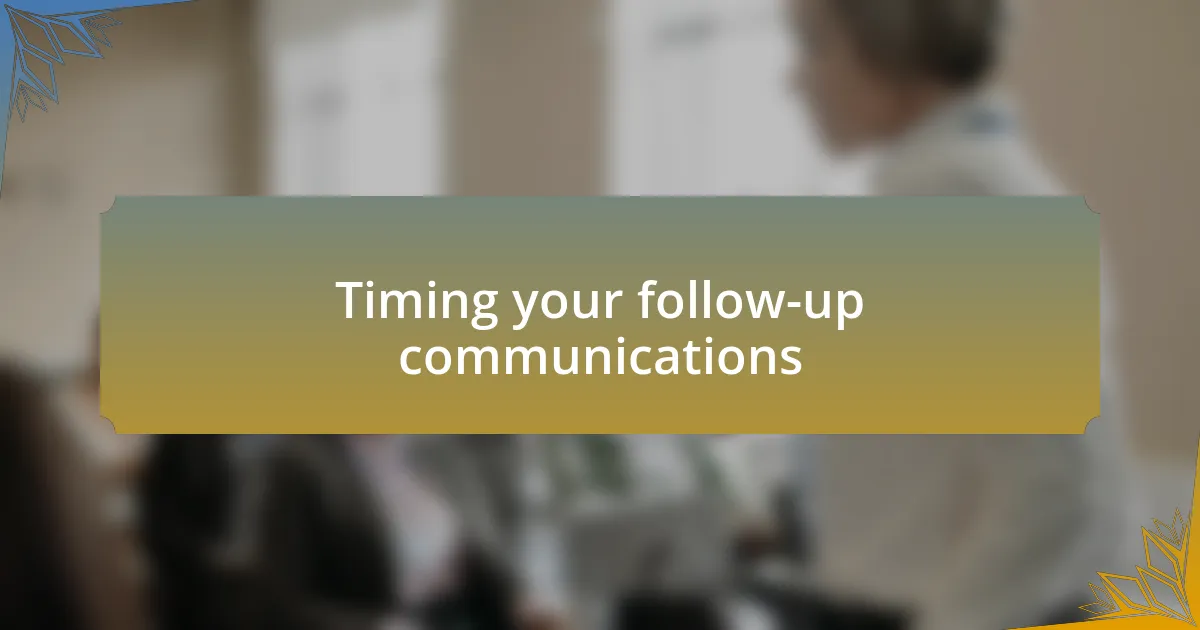
Timing your follow-up communications
Timing your follow-up communications is crucial to maintaining momentum after a meeting. I’ve learned that reaching out within 24 to 48 hours can make a significant difference. For instance, I followed up the next day after an important client meeting, and the timely communication made my client feel valued and prioritized. Have you noticed how responsiveness can bolster a relationship?
I also consider the context of the meeting when deciding on follow-up timing. During one conference, I connected with a potential partner whose energy and ideas resonated with me. I strategically waited until their busy week had passed before reaching out, acknowledging their schedule. It’s amazing how timing can show respect for others’ commitments; have you thought about how adjusting your timing reflects your understanding of their situation?
Moreover, don’t underestimate the power of seasonal timing. After a conference in the fall, I followed up with attendees just before the holiday season. The cheerful approach combined with a reminder of our discussions made my emails more engaging and memorable. Have you ever thought about how aligning your follow-ups with seasonal themes could enhance your connection?
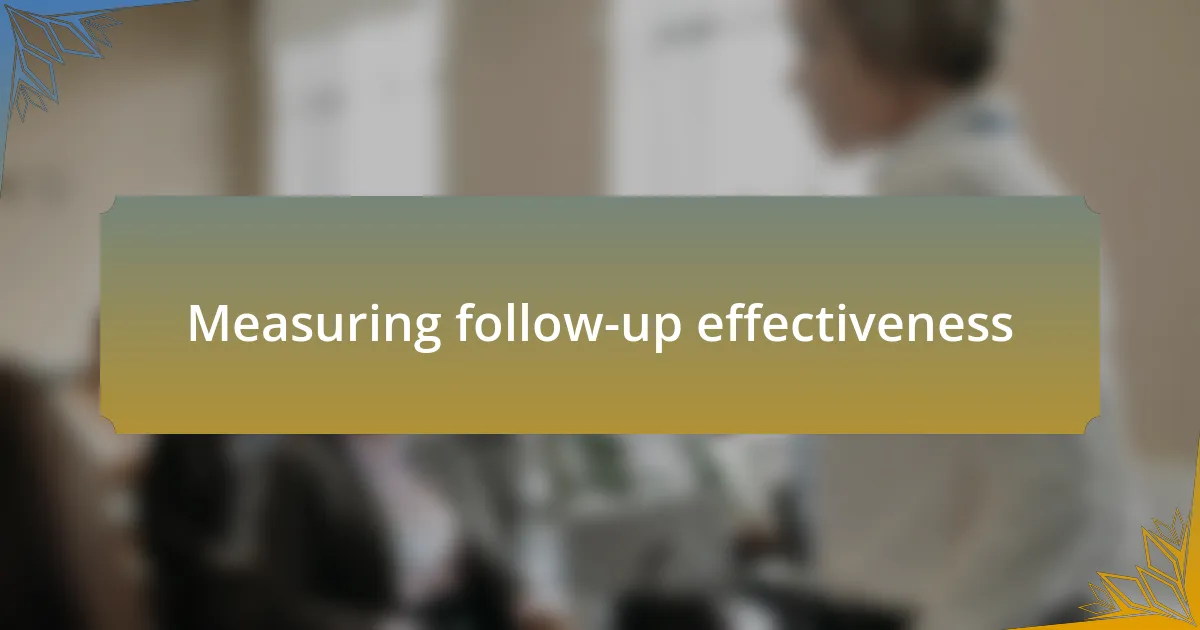
Measuring follow-up effectiveness
Measuring the effectiveness of my follow-up communications is something I take seriously. I often analyze response rates and engagement levels to determine if my messages are resonating. For example, I once implemented a simple survey for clients after my follow-up emails. The feedback revealed that personal touches, like referencing specific points from our meetings, significantly increased response rates. Have you thought about how small details might make a big difference in your outreach?
Another aspect I focus on is tracking outcomes from my follow-ups. I like to create a system that categorizes leads based on their responses. In my experience, those who replied positively often became long-term clients. Conversely, those who didn’t respond gave me insight into where I needed to adjust my approach. This method has not only improved my follow-up strategy but also sharpened my understanding of client needs. What metrics do you find most helpful in gauging connection with your clients?
Lastly, I pay attention to qualitative feedback I receive during these interactions. Sometimes, clients share insights that go beyond a simple yes or no. I remember one instance when a client opened up about their struggles during a follow-up call, prompting a deeper conversation about tailored solutions. This highlighted how effective follow-ups can lead to more significant, more profound relationships. Have you explored the depth of conversations that can emerge from a well-timed follow-up?